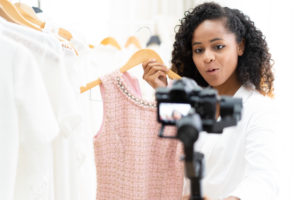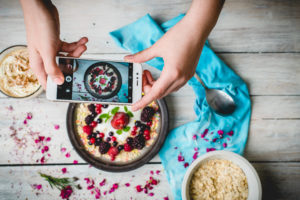Image courtesy of Diggity Marketing
We’re living in a world of constant “influence”. Influencer marketing has exploded in recent years, as social media has become an integrated and essential part of our daily lives. Whether you’re on the subway, walking down the street or waiting at a restaurant, it’s not uncommon to find most people passing time by scrolling through Instagram, Facebook or Twitter. What some don’t realize is the power of the content they are seeing and how it truly influences their decisions and opinions.
It’s no doubt that consumers are turning to their favorite Instagram models, Twitter personalities and YouTube stars for advice on products or companies, and recommendations on where to go, what to do and how to do it. Because of its power, many brands are turning to influencer marketing to directly target a niche audience in an approach that’s more cost-effective than traditional advertising.
Although influencer marketing is a billion-dollar industry, the question still stands: what is the real benefit of partnering with an influencer in today’s digitally driven world beyond the pretty picture for followers to see?

Brand Awareness
Whether you’re representing a hotel, restaurant, beauty product or fashion brand, the name of the game is to raise brand awareness to help the brand stay successful in its competitive environment. As PR professionals, we know that there’s nothing more important than knowing your client’s target audience and how to grab the attention of those individuals.
By choosing the right influencer, you are promoting your brand to a group of people or followers who trust the influencer’s opinion. The followers made an active choice to follow this influencer and, as a result, a level of trust has been established. This trust allows for the influencer to feel more like a friend than a talking head in a commercial – increasing the chances someone will engage with or share the post, and ultimately increasing popularity and driving awareness for the brand.
Influencer Marketing by the Stats
Even with various real-life experiences and client case studies, many still doubt the impact of influencers. According to SocialMediaToday, businesses who understand influencer marketing gain impressive returns.
In addition, Influencer Marketing Hub recently surveyed nearly 800 marketing agencies, brands and other relevant professionals to determine their views and build insight on the industry. Below are some key statistics that are important to keep in mind when making educated recommendations to clients and partners:
- Instagram’s usage grew 10 x over 5 years
- Instagram engagement rates are much higher than those on Twitter
- There were 320 more platforms and influencer marketing focused agencies created last year
- 92 percent of people think influencer marketing is an effective form of marketing
- A large amount of businesses plan on dedicating a budget to influencer marketing this year
- Engagement or click-through is the most important criteria when evaluating influencers
Choosing the Right Influencer
From a PR perspective, it’s crucial to set your client up with the right influencer. Remember, it’s not all about the “pretty picture” or large number of followers someone may (appear) to have – you should consider the three “Rs” when navigating through the influencer marketing landscape.
- Relevance: A relevant influencer caters to your target audience
- Reach: The number of individuals you can get attention from
- Resonance: The amount of engagement an influencer can create
Something else to keep in mind is that today’s influencers typically require some sort of payment – whether that means receiving a free product or an all-expense paid destination visit, there is likely some sort of barter or cost associated with the partnership.
While a fashion influencer may post a beautiful bikini shot on the beach that looks like pure #goals, there’s often much more than meets the eye: Just one photo can take hours to shoot on top of more time spent editing, and the influencer likely has an overarching strategy of their own that’s needed to keep their feed cohesive. There are also analytics to consider before posting – do images with more blue tend to do better? Do the followers tend to engage more early morning? Are the likes higher when the influencer’s boyfriend joins the shot?

Real Life Proof That Influencer Marketing Works
One of the most recent and most outrageous influencer marketing case studies out there is focused on Fyre Festival. Whether you watched the Hulu or Netflix documentary (or maybe both…#guilty), one thing is certain – the power of social media influencers is immense. Thousands of people viewed posts from various and well-respected social media stars about an infamous music festival, and because people have established a trust with these influencers, countless amounts of consumers bought tickets to this event without knowing anything more than the soundbites the influencer pushed out. The result? A mess that left thousands stranded in the Bahamas with little more than hurricane shelter-like tents and bad sandwiches.
On the flip-side, social media outlets can be so successful that the influencer can leverage their popularity and admiration into a full fledged business. Social media influencer and entrepreneur Julia Engel, who currently has over 1.2 million followers, started her blog, Gal Meets Glam, in 2011. From the start, the blog featured style, beauty, travel and home content that appealed to a large audience. Julia’s love for “all things feminine” inspired a dress line in 2018, with products carried on her site and in major luxury department stores, like Nordstrom and Dillards.
The real reason influencers continue to make such breakthroughs is yet another “R” word: Relatability. The relationship the public builds with social media influencers is unlike any relationship the media landscape has seen before. Social media influencers have the ability to create a conversation with their followers regardless of location and, as a result, consumers can ask questions in real-time and get authentic feedback. It’s not Jennifer Aniston selling them lotion, but someone they have grown to admire and trust.
Many lifestyle influencers are also posting about their personal lives in addition to a destination they just visited or a unique piece of clothing they received, to help their followers experience the type of person they are and establish other avenues of connection. Despite their large size, many influencers and their followers share the same demographic traits and interests, creating the feeling of having an established relationship with the person.
As technology continues to evolve into the future, social media influencers will adapt alongside it. In the meantime, give some of your favorite influencer’s photos a few double taps – after all, it’s much more than just a pretty picture.

